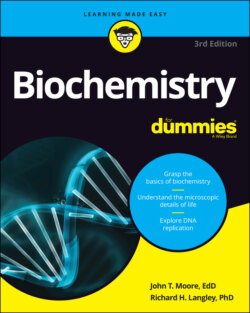Читать книгу Biochemistry For Dummies - John Moore T., Richard Langley H., John T. Moore - Страница 21
Understanding the pH scale
ОглавлениеExpressing hydrogen ion concentrations in an exponential form, such as , isn’t always convenient. Thankfully, you have a way of simplifying the representation of the hydrogen ion concentration: the pH. You can calculate the pH for any solution by using the following equation:
For instance, in the case of a solution with a hydrogen ion concentration of , the pH calculation would be
Table 2-1 gives similar calculations for some hydrogen ion concentrations.
TABLE 2-1 The pH Scale and the Associated Hydrogen Ion Concentration
| pH | Solution Property | |
|---|---|---|
| 0 | Acidic | |
| 1 | Acidic | |
| 2 | Acidic | |
| 3 | Acidic | |
| 4 | Acidic | |
| 5 | Acidic | |
| 6 | Acidic | |
| 7 | Neutral | |
| 8 | Basic | |
| 9 | Basic | |
| 10 | Basic | |
| 11 | Basic | |
| 12 | Basic | |
| 13 | Basic | |
| 14 | Basic |
Solutions with a pH less than 7 are acidic. Solutions with a pH greater than 7 are basic. Solutions whose pH is 7 are neutral. The pH of pure water is 7. Be careful, though: Not every solution that has a pH of 7 is pure water! For example, if you add table salt to water, the pH remains at 7, but the resulting solution is certainly not pure water.
The pH scale is an open-ended scale, meaning that a solution can have a pH greater than 14 or less than 0. For example, the pH of a solution of hydrochloric acid is . John loves to ask questions based on this topic to his advanced chemistry students! The scale is a convenient part of the pH scale for most real-world solutions — especially ones found in biochemistry. Most biological systems have a pH near 7, although significant deviations may exist (for example, the pH in your stomach is close to 1).
